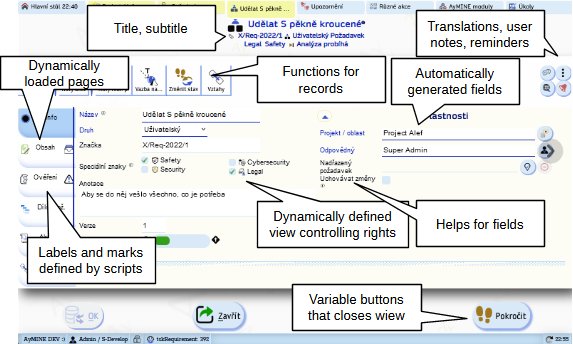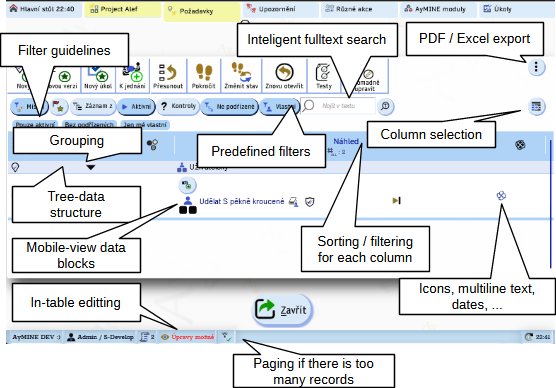
The functionality implemented in the application is available for all modules and forms the basis of the user interface.
The user interface is the most visible, so let's start with it. The main specialty of the interface is that it is dynamically generated, it can be easily modified even in a mobile app without the user having to install an update. How is that possible. Simply because you don't program it, but you define it. Some frameworks use the term templates, but AyMINE went much further than Laravel, for example. Moreover, in AyMINE, the interface is the app in the browser, so it's orders of magnitude faster than Laravel, Symphony, or Django.
Several years of improvements shifted records detail to almost ultimate possibilities

Table of records is the key UI object. Our table supports editing like Excel but although intelligent tree-like data structure, field formatting, sorting, filtering, paging etc:

We've been really careful about security. Not only are there system rights attached to every record, but also to every view, field, and function.
In addition, the rights are controlled by several levels:
The framework was designed from scratch to be ideal for SaaS applications. We provide SaaS services in it ourselves, so we've tested ourselves that everything is as it should be:
We pay great attention to the selection of technologies, modules and libraries. Why? We know the experience of teams who threw away years of work when Angular 1 lost its drive.
Almost everything we use could be easily replaced except for the basic one - in which the server's system and business logic is written.
First of all, the main thing: the server is primarily in PHP. Why the introduction? Because we know that many programmers refuse to admit that PHP is robust or fast. We won't go into the details here, but months of tests have convinced us that:
Java and Node are better for gaming servers, for example, we have no doubt about that. But we offer you a framework for SaaS services, not a framework for online gaming. And that makes a big difference. And while we're at it: AyMINE server works with Node. And it's no problem to integrate modules in Java or anything else via https services or otherwise.
Discussers can tell us again what kind of database it is - SQL. That's the language. Well, of course we know that. But really: AyMINE uses SQL and will get along with any SQL database. Of course, it uses, for example, a JSON type field that the SQL standard of the last millennium doesn't know, but all modern SQL databases do.
Primarily, AyMINE uses a MySQL clone, specifically MariaDB. If you want to pay extra, you can use Oracle, MS SQL or any other. We know them and we say quite responsibly that you won't get anything against MariaDB and especially against its commercial version (still fundamentally cheaper). In AyMINE, of course (so that merchants don't sue us).
AyMINE doesn't require Sharepoint, Google or any other commercial platform. Thanks to that, we can also offer SaaS system at a price that only buys user access to cloud services elsewhere.
That we're behind? But no. For example, AyMINE is connected to ChatGPT 4. It takes advantage of its possibilities, but it's not needed for running the system. And most importantly: you don't need it for any user. So the application won't cost you for cloud fees, which can do a lot, but they also take a lot.
It's easy to write that something is robust. It's harder to prove it. That it's not an empty term?
What's behind it:
In the last place, but certainly not the last in meaning, we mention an important feature - support of independent development of modules by separate teams. Modules can work completely independently, you can manage and change them independently. You can only provide modules to some users. Each module can use its own database and, in principle, its own server. All this is expected.
25+ years of experience – © PDQM, Ltd. 1997-2007-2023;
Copyright and Legal Disclaimer;